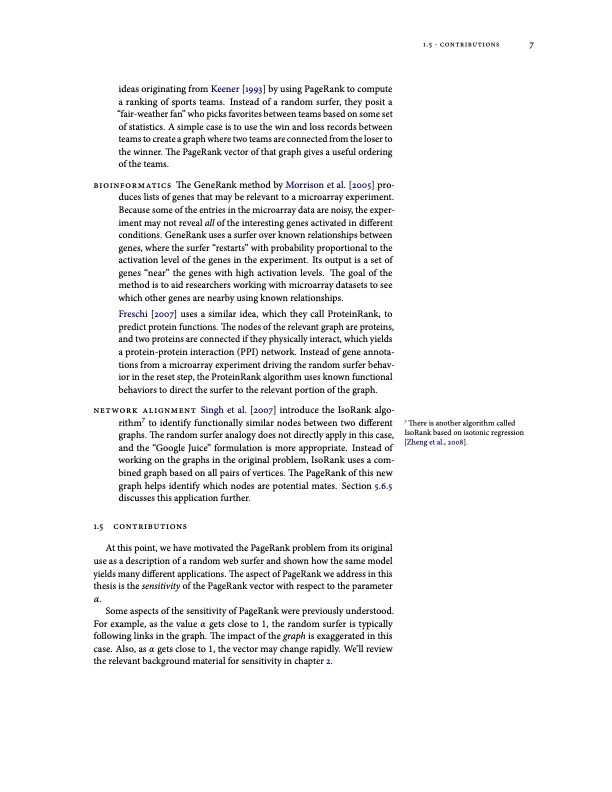
PDF Publication Title:
Text from PDF Page: 027
ideas originating from Keener [1993] by using PageRank to compute a ranking of sports teams. Instead of a random surfer, they posit a “fair-weather fan” who picks favorites between teams based on some set of statistics. A simple case is to use the win and loss records between teams to create a graph where two teams are connected from the loser to the winner. The PageRank vector of that graph gives a useful ordering of the teams. bioinformatics The GeneRank method by Morrison et al. [2005] pro- duces lists of genes that may be relevant to a microarray experiment. Because some of the entries in the microarray data are noisy, the exper- iment may not reveal all of the interesting genes activated in different conditions. GeneRank uses a surfer over known relationships between genes, where the surfer “restarts” with probability proportional to the activation level of the genes in the experiment. Its output is a set of genes “near” the genes with high activation levels. The goal of the method is to aid researchers working with microarray datasets to see which other genes are nearby using known relationships. Freschi [2007] uses a similar idea, which they call ProteinRank, to predict protein functions. The nodes of the relevant graph are proteins, and two proteins are connected if they physically interact, which yields a protein-protein interaction (PPI) network. Instead of gene annota- tions from a microarray experiment driving the random surfer behav- ior in the reset step, the ProteinRank algorithm uses known functional behaviors to direct the surfer to the relevant portion of the graph. network alignment Singh et al. [2007] introduce the IsoRank algo- rithm7 to identify functionally similar nodes between two different graphs. The random surfer analogy does not directly apply in this case, and the “Google Juice” formulation is more appropriate. Instead of working on the graphs in the original problem, IsoRank uses a com- bined graph based on all pairs of vertices. The PageRank of this new graph helps identify which nodes are potential mates. Section 5.6.5 discusses this application further. 1.5 contributions At this point, we have motivated the PageRank problem from its original use as a description of a random web surfer and shown how the same model yields many different applications. The aspect of PageRank we address in this thesis is the sensitivity of the PageRank vector with respect to the parameter α. Some aspects of the sensitivity of PageRank were previously understood. For example, as the value α gets close to 1, the random surfer is typically following links in the graph. The impact of the graph is exaggerated in this case. Also, as α gets close to 1, the vector may change rapidly. We’ll review the relevant background material for sensitivity in chapter 2. 7 There is another algorithm called IsoRank based on isotonic regression [Zheng et al., 2008]. 1.5 ⋅ contributions 7PDF Image | ALGORITHMS FOR PAGERANK SENSITIVITY DISSERTATION

PDF Search Title:
ALGORITHMS FOR PAGERANK SENSITIVITY DISSERTATIONOriginal File Name Searched:
gleich.pdfDIY PDF Search: Google It | Yahoo | Bing
Cruise Ship Reviews | Luxury Resort | Jet | Yacht | and Travel Tech More Info
Cruising Review Topics and Articles More Info
Software based on Filemaker for the travel industry More Info
The Burgenstock Resort: Reviews on CruisingReview website... More Info
Resort Reviews: World Class resorts... More Info
The Riffelalp Resort: Reviews on CruisingReview website... More Info
| CONTACT TEL: 608-238-6001 Email: greg@cruisingreview.com | RSS | AMP |